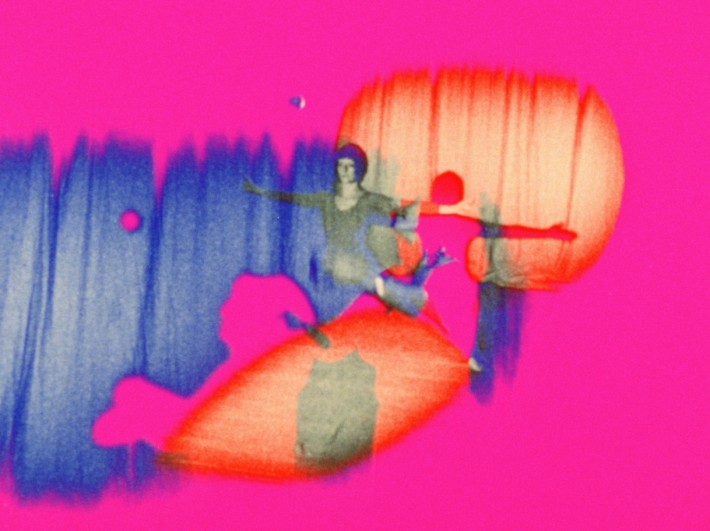The Riddles of the Sphinx
The Riddles of the Sphinx (1977/2013). GB. 2013. DVD. BFI home video. 92 minutes + 115 minutes extras. £15.99
 About the reviewer: Dr Patti Gaal-Holmes is an artist/filmmaker and historian. Her cross-disciplinary practice includes working with moving image (celluloid and digital), photography, drawing, artists’ books and performance. She is Reviews Editor for the Intellect journal, Transnational Cinemas, and completed a doctoral thesis on A History of 1970s British Experimental Film, which is the subject of her forthcoming publication from Palgrave Macmillan in 2015.
About the reviewer: Dr Patti Gaal-Holmes is an artist/filmmaker and historian. Her cross-disciplinary practice includes working with moving image (celluloid and digital), photography, drawing, artists’ books and performance. She is Reviews Editor for the Intellect journal, Transnational Cinemas, and completed a doctoral thesis on A History of 1970s British Experimental Film, which is the subject of her forthcoming publication from Palgrave Macmillan in 2015.
The release of the BFI’s High Definition DVD, The Riddles of the Sphinx, is a welcome contribution to the field of historical film texts, not only for committed enthusiasts and researchers of formally experimental 1970s counter cinema, but also for scholars and filmmakers new to this material. Its value as an educational tool for staff and students alike is realised not only through the newly mastered film, but also in the Special Features presented on the DVD. These include Laura Mulvey and Winfried Pauleit’s feature-length optional audio commentary, Laura Mulvey in Conversation, the earlier film by the directorial duo, Penthisilea: Queen of the Amazons (1974), and an illustrated booklet with a 1977 film review and newly commissioned essays.

The Riddles of the Sphinx uses the Oedipus myth to frame the film’s narrative, centring on a mother’s (Louise) close relationship with her young child, as she finds a sense of separation and independence from her daughter. The Freudian usage of the Oedipus myth, introduced to Mulvey through a 1970s women’s reading group (The History Group), follows the child’s transitional phase of dependence from the imaginary maternal relationship to the symbolic paternal one.[1] In the film the mother’s loving, but sometimes smothering, closeness with her child impacts on the parental relationship, leading to the father’s departure from the family home. The ensuing situation results in Louise taking up work as a switchboard operator, placing her daughter in a nursery, and getting involved in trying to resolve effective childcare at her place of work.
The formal and aesthetic devices used in the film are central to its theoretically informed premise, with Mulvey and Wollen taking an anti-narrative stance informed by the film theories of, amongst other, Jean-Luc Godard and Andre Bazin. Sphinx provided Mulvey and Wollen the opportunity to put into practice their interests in counter-cinema and avant-garde filmmaking and should be considered as an extension of their work as film theorists and academics. Mulvey’s seminal (and oft-referenced) essay ‘Visual Pleasure and Narrative Cinema’ (1975) informed this collaborative project, as did Wollen’s essays like ‘Godard and Counter Cinema: ‘V’ent d’est’ (1972) and ‘The Two Avant-gardes’ (1975). Mulvey cited the influence of film directors Sergei Eisenstein, Dziga Vertov and Jean-Luc Godard as they demonstrated an integral link between form and content, establishing new possibilities for narrative experimentation critical for opening up new feminist polemics in 1970s filmmaking:
Semiotics foregrounds language and emphasises both the crucial importance of the signifier (for a long time overlooked and subordinated to the signified) and the dual nature of the sign, thus suggesting the aesthetic mileage that can be gained by play on separation between its two aspects. For feminists this split has a triple action: aesthetic fascination with discontinuities; pleasure from disrupting the traditional unity of the sign; and theoretical advance from investigating language and the production of meaning.[2]
Formal experimentation in the film, which is divided into seven sections of varying duration includes the use of thirteen 360° pans, each one revealing an aspect of Louise’s environment which moves from the intimacy of the home to the child’s nursery, her place of work and finally onto a busy London traffic roundabout. Formal limitations were also used in Mulvey and Wollen’s earlier film, Penthisilea, in which a single shot was used for each reel of 16mm film. Other scenes in the film include Mulvey speaking directly to camera, actors in shot with and without synced sound. The soundtrack, scored by Mike Ratledge, is sensitive to the experimental formal approaches with either synched everyday sounds used or classic synth music. Fragmentary written texts (by Wollen) were also used to introduce parts of the film.
Two sections of the film foregrounding the materiality of the medium include re-filmed footage of the Giza sphinx in the opening sequences and colour-saturated and reworked footage of acrobats towards the end of the film. In the former archival footage of the sphinx was projected using a 16mm Motion Analyser Projector to significantly slow down the material for re-filming, resulting in a grainy, painterly quality with some extreme close-ups of the sphinx. In the latter, footage of acrobats, which has been rendered through experimental film editing and processing is shown in abstracted bright flares of colour.
An understanding of the complex layering of material, the formal and aesthetic strategies, details of the filmmaking process and influences are enhanced by the Special Features of the DVD. Mulvey and Pauleit’s audio commentary, Mulvey’s interview and the essays in the booklet provide deep insights into the film, helping navigate the newcomer and providing in-depth retrospective reflections for specialists in the field. All of these make it an invaluable package, shedding retrospective light on this complex and important film, which needs to be considered within the frameworks of its production, namely 1970s socio-political contexts, counter cinema and avant-garde filmmaking.
Dr Patti Gaal-Holmes
[1] The History Group met regularly to discuss theoretical texts and included women like the artist, Mary Kelly, and the psychoanalyst, Juliet Mitchell. In one section of Riddles of the Sphinx a film about Kelly’s Post Partum Document is being worked on by Louise’s husband.
[2] Laura Mulvey, ‘Film, Feminism and the Avant-Garde’ in Michael O’Pray (ed.), The British Avant-garde Film: 1926-1995: An Anthology of Writings, op. cit., pp. 199-216; p. 211.

 Learning on Screen
Learning on Screen